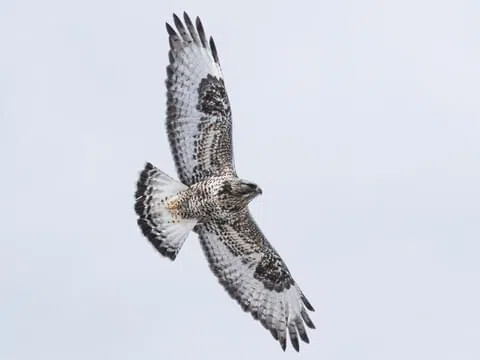Written by Kennedy Zittel
Who doesn’t love to watch the sunrise? The oranges, pinks, and reds light up the sky and cast a soft warm glow over the ground below. During the winter, one of my favorite things to do is to watch the sunrise shine upon the frost-covered prairies here at Woodland Dunes. As I watch the shimmering plants sway in the wind, I scan the sky for a glimpse of one of my favorite winter-time visitors. If I am lucky, I spot a large hawk hovering in the air over the tall grasses. With a 4-5 foot wingspan and named for the feathers that extend down its legs to its toes… a rough-legged hawk!
Rough-legged hawks have a dark brown body with a lighter-colored underside. They have a black-tipped tail and a lighter-colored tail base. There is a lot of color variation in this species, as they can also come in both light and dark morphs!
This is a special sight – as we can only see these beautiful hawks during the winter. They spend the breeding season in either tundra or taiga habitats, with their population split between the North American continent and the Eurasian continent. At their chilly breeding grounds, they hunt for small rodents like lemmings and voles. There are few trees to perch on in their summer breeding grounds. As such, these hawks have the ability to hover in the air to scan the ground below them for a bite to eat.
Rough-legs travel south for winter, searching for open habitats like prairies, deserts, marshes, and fields. Some choose to spend the winter here in Wisconsin with us! During the winter they hunt for small rodents like mice, voles, and shrews. Though they are large birds, they have very small feet – an adaptation for catching their small prey.
If you can’t spot them hovering or soaring above the prairies, another good spot to look for these amazing birds is at the tops of trees nearby! Because of their small feet they can perch on the small branches at the tops of trees, a spot where other large hawks (like red-tails) cannot perch.
Climbing up the observation platform at the Henry Wetland area of our preserve (off of Woodland Drive) can offer a good vantage point for viewing this beautiful hawk soar above the wetland. While you are out there, you could spot other hawk species as well, including red-tailed hawks and northern harriers! If you have the chance this winter, on a “warm” winter morning, try to get out there and watch the sunrise over the beautiful winter landscape, and keep your eye out for what wildlife is out there with you.












